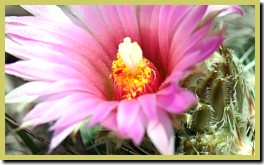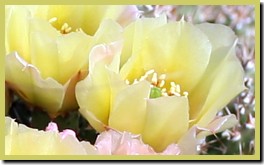
Manitoba Cacti
Gardening without watering?Xeriscaping is a hot topic in gardening these days. Creating gardens and landscapes that can get by with only the water that nature provides as rain and melting snow is an environmentally responsible thing to do. However, finding plants that can tough-it-out on their own can be a challenge. Manitoba snowbirds that vacation in the US southwest are likely familiar with cacti and the growing use of these native plants in sun-belt landscaping. Though many of us have cacti as houseplants, we don’t often think of them as garden species, but we should, because there are cacti native to Manitoba that we can grow outdoors. Manitoba has two native cacti, the Brittle Prickly Pear (Opuntia fragilis) and the Pincushion Cactus (Escobaria vivipara). They’re both common in the southwest of the province, in open, prairie habitats with sandy soils. Spruce Woods Provincial Park is a great place to see both species. The Brittle Prickly Pear can even be found in the southeast, in the Whiteshell Provincial Park, where it grows on exposed rocky outcrops; conditions harsh enough to match any desert. |
||
Manitoba Cacti
In southern Saskatchewan and Alberta, there is another hardy cactus, the Prickly Pear (Opuntia polycantha) that could also be grown in Manitoba gardens. It is much larger than its cousin, the Brittle Prickly Pear. The pads may be up to the size of the palm of your hand and reach to 15 cm in height, but the growth form is largely decumbent. Our native cacti bloom in late June or early July. The flowers are short-lived, but very attractive and quite large, for the size of the plants. Pincushion Cactus blossoms are a bright fuschia colour, while the Prickly Pears both have creamy yellow flowers. Those of the larger Prickly Pear can be 8 cm across. Cultivating cacti for your garden is not difficult, but requires patience. Cacti are slow growing perennials. Of the 3 species, the Brittle Prickly Pear is easiest to grow because it readily reproduces vegetatively. It draws its name from the ease with which it can be broken up into separate pads. Its main means of dispersal in the wild is for pads to be carried to new locations by passing animals. The spines will stick into the fur of an animal, or the clothes of a person, and an entire pad will broken off and deposited elsewhere. The larger Prickly Pear can be grown from separated pads, too. For both species, individual stem pieces (pads) placed on a sandy soil mixture will quickly take root. |
||
|
||
Grow Your Own
You can also collect seeds from wild cacti and grow your own. The Pincushion Cactus produces juicy berries (edible, delicious and full of seeds) by late August. The Prickly Pears produce fleshy, pear shaped fruits (hence the name) which are also quite tasty. Seeds extracted from the fruits can be stored, stratified and planted the following spring in a sandy potting mixture. An important thing to bare in mind when cultivating cacti is that from late fall to late spring, native cacti can look like they are dead. To survive freezing they greatly reduce the water content of their pads and appear brown and withered. However, they will “come alive” again in late spring, after a few good rains, and produce new pads and flowers. In ClosingIf you’re looking for something really unusual to grow, or if you’re into “eXtreme xeriscaping”, then native cacti are the ultimate addition to your garden. |
||
|
| You can help NatureNorth produce more great articles with a secure donation through PayPal. Our Google Adsense ads pay our server costs, but that's about it. To learn more follow this link: Support NatureNorth. Thank-you! | |


